Patch: Dangerine
menu: File -> Library -> Community -> tiar -> synths -> Dangerine
Aftertouch and chorusing echo...

menu: File -> Library -> Community -> tiar -> synths -> Dangerine
Aftertouch and chorusing echo...
menu: Help -> Library -> Community -> tiar -> kfilter -> LPRiseDecay
It is a first order lowpass filter, with separate controls for Rise and Decay rates.
It can be used to smooth control signals with distinct rising and falling rates.
I find it useful on midi signals such as aftertouch.
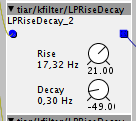
try menu: Help -> Library -> Community -> tiar -> filter -> ZDF SVF 1 for instant psychédélic.
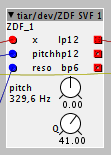
ZDF SVF 1 is still in dev, so feedback is welcome.
It is designed to be a "heavy duty" state variable filter, it must be capable of enduring deep and fast modulations without becoming unstable.
This object is a so called "Zero Delay Feedback" filter based on a design i made some years ago.
It is based on the "step invariant" transform (as opposed to the omnipresent bilinear transform).
The main advantage of this method is that its frequency response is similar to analog filters even in the high range of the spectrum (no frequency warping).
The maths behind it are a little more complicated than the usual trapezoïd ZDF.
For details, you can have a look to the jsfx/Reaper thread, there is two or three posts discussing transition matrixes...
try menu: Help -> Library -> Community -> tiar -> kfilter -> median
This is a 3 tap median filter for noisy control signals.
This can be useful if you have to deal with noisy control signals with random spikes or noise. This can be the case with some midi aftertouch controllers or when using analog inputs.
The main advantage of the median filter - compared to a low pass filter - is that it is more efficient for this kind of issue and it does not smooth the signal as much.
try the help patch to get an idea:
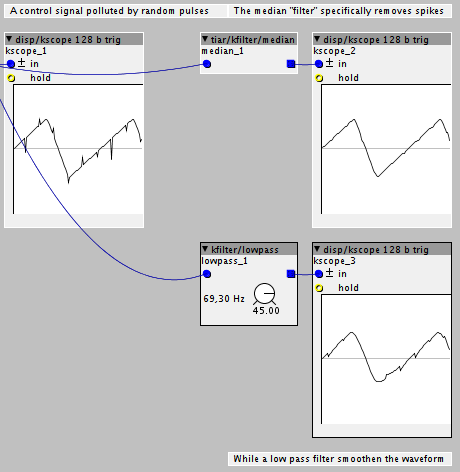
Note: median filters can be chained to process noisier control signals (when it is not possible to get cleaner signals from the hardware). Experiment and use kscope to see what it does to your control signals.
see menu: Help -> Library -> Community -> tiar -> kfilter -> medianChained.axh
menu: File -> Library -> Community -> tiar -> synths -> SpaceClarinet
Similar to "Dangerine" but based on the FiveSteps and SixStepsBLI oscillators from tiar->osc.
try menu: Help -> Library -> Community -> tiar -> filter -> ZDF SVF 2
It is similar to the ZDF SVF 1 filter with an audio rate pitch modulation inlet.
It allows unusual filter modulations (and even feedback) found in some analog synths.
try menu: Help -> Library -> Community -> tiar -> dist -> SyncAlias
"8bit" sounds with a "sync touch".
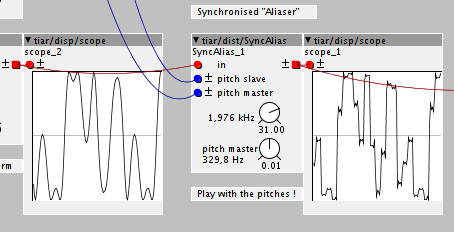
I'm sort of an Anti Aliasing freak, it is quite an obsession since I bought my first synth, a Roland D5.
SyncAlias is quite special.
It is anti aliased so that it does not alias with the 24kHz Nyquist frequency specific to the axoloti.
But it is designed to simulate aliasing at rates below 24kHz, so that one can simulate old digital synths.
The resampling frequency can be modulated with the pitch slave and pitch master inlets.
If the pitch master is related to the pitch of the input signal, you will get consonant results. The pitch slave allowing sync sweeps. This is the case with the help patch.
Detuning the master pitch from the pitch of the input signal creates a dissonant sound (end of the test track). Typical low fi aliasing...
see the help patch: menu: Help -> Library -> Community -> tiar -> tuning ->DetHz
An old trick to get the fat synth sound consists in slightly detuning oscillators.
With the axoloti, it is often achieved by ctl-shift mouse drag over the pitch knob of the oscillator (or by selecting the knob and typing in accurate values thanks to @lis0r ). This is pitch detuning.
A slight detuning generates that slow, smooth and delightful chorusing / doubling effect.
The problem with pitch detuning is that the chorusing rate increases in the higher range. It is often too fast and more fuzzy than smooth.
DetHz allows to have a constant chorusing rate all over the keyboard. It adds a frequency offset - as opposed to a pitch offset - to the control signal:
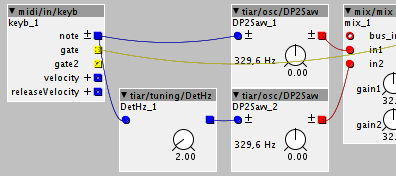
Both oscillators are tuned exactly the same way, but DetHz modifies the pitch control of DP2Saw_2. DP2Saw_2 is "frequency detune" relative to DP2Saw_1.
Try the help patch: Help -> Library -> Community -> tiar -> tuning ->DetHz and play notes from the lower end of the keyboard to the higher end.
Here are the approximate detuning cycle/rates you will get with the control parameter:
[EDIT 27 feb 2018] Added an inlet to modulate the offset ie control the beat/chorusing speed.
try menu: Help -> Library -> Community -> tiar -> osc -> wf_16_harm
is a companion object for the 16 segment anti aliased oscillator tiar/osc/16StepsDP2.
It allows to control 8 harmonics and the interpolation type, linear, steppy or even reversed.
This interpolation type allows to recreate harmonic imaging typical of old semi digital synths.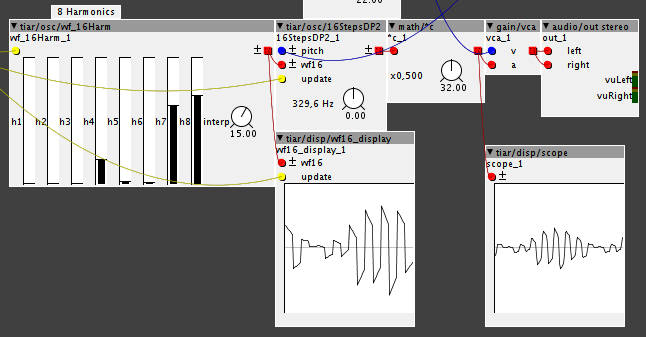
menu: File -> Library -> Community -> tiar -> synths -> ToTheStars
This 8 voice patch uses a pair of new 6coseg m oscillators per voice and a feedback delay.
Phasing and filter effects are produced by modulations of the 6coseg m waveform parameters.
try menu: Help -> Library -> Community -> tiar -> lfo -> 555LFO
This LFO mimics the LFO waveforms of astable oscillators used in some analog effects (such as phasers and flangers).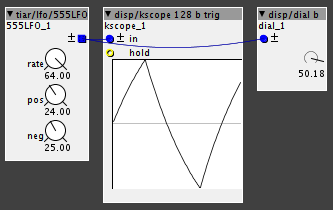
pos and neg add some asymmetry.
try Help -> Library -> Community -> tiar -> osc -> SelfPMSync
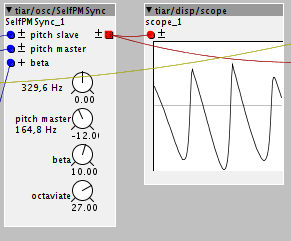
This is a band limited sawtooth generator with embedded master oscillator. It allows to produce some classic analog sync sounds (try the help file).
try menu: Help -> Library -> Community -> tiar -> artic -> sentence1 (play legato notes and chords and see how vowels are chained).

sentence1 is sort of a note counter.
It counts how many notes you have played, its output can be used to chain parameter changes (such as formants in the example).
Note: This example help patch uses sentence1 to control a @lokki s formantsettings object that controls a bunch of SyncPM2.
Now.. we can try to add different transitions between vowels...
http://www.phon.ucl.ac.uk/courses/spsci/acoustics/week2-5.pdf
http://www.phon.ucl.ac.uk/courses/spsci/acoustics/week2-6.pdf
but, i think that it is somewhat tricky !!
well you can fade between s1 and s2 in my formantsettings objects. (via the c inlet, but you have to set them to different vowels to hear actually a difference) otherwise s2 is actually pretty much useless 
but i imagine you want a different transition...
Yes, da di de do du !
I will experiment withh short stops, formant deviations and noise bursts, will be fun !
more like:
ai ae ao au
ia ie io iu
ea ei eo eu
oa oi oe ou
ua ui ue uo
but stops deviations and bursts sound great to me!
try menu: Help -> Library -> Community -> tiar -> osc -> DevilSync
I call this osc "devil" because its waveform looks like horns...

It is antialiased - including the master sync - by a first order differentiation algo.